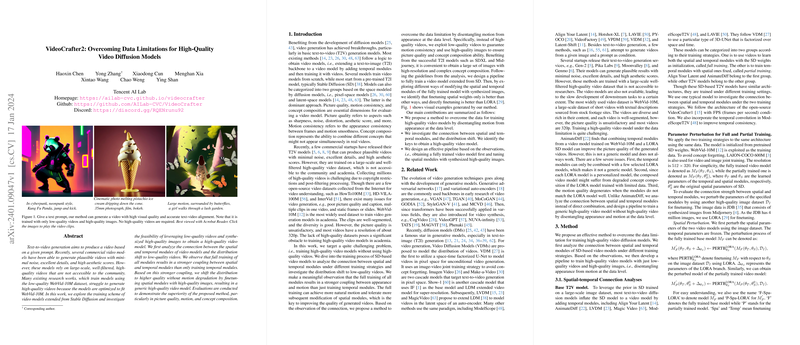Introduction to VideoCrafter2
Researchers from Tencent AI Lab have developed a novel approach to overcome the significant challenge of generating high-quality videos using diffusion models. VideoCrafter2 does not depend on large-scale, high-quality video datasets, which are often out of reach for the research community due to accessibility and copyright issues. Instead, their methodology leverages a combination of low-quality videos and synthesized high-quality images to produce videos that are not only of high visual quality but also exhibit accurate text-video alignment.
Methodology Insights
The conventional way of training video models utilizing diffusion techniques involves adding temporal modules to a text-to-image (T2I) backbone model and training with videos. Two distinct approaches manifest as fully training all modules of the video model or only training the temporal modules with the spatial ones fixed. The VideoCrafter2 research delves deep into these models and discerns a stronger coupling between the spatial and temporal modules when fully training the model. This strength allows for more natural motion in videos and provides resilience to subsequent modifications of spatial modules.
Overcoming Data Constraints
The key innovation of VideoCrafter2 lies in decoupling motion and appearance in video generation. This separation allows the model to learn motion dynamics from low-quality video clips, while picture quality and concept accuracy are enhanced through synthesized still images known for their high resolution and complexity. The researchers found that fine-tuning only the spatial dimensions of the fully trained base model with high-quality images was more effective than altering both spatial and temporal dimensions or other strategies evaluated.
Results and Contributions
Comparative analyses show that VideoCrafter2 delivers on multiple fronts, achieving motion consistency and high picture quality through a strategic training pipeline. The work primarily makes three contributions:
- It introduces a method to train high-quality video models without the need for high-quality video datasets.
- By examining the relationship between spatial and temporal modules, the research identifies key ways to achieve a high-quality video model.
- An effective training pipeline is designed based on the insights gained about disentangling appearance from motion at the data level.
Conclusion
In summary, VideoCrafter2 represents a significant step forward in video generation using diffusion models. It demonstrates that by smartly leveraging available resources like low-quality videos and high-quality still images, it is possible to generate videos with impressive visual detail and content accuracy. This approach potentially paves the way for advancements in video generation, making it more accessible for researchers and practitioners by circumventing the need for hard-to-obtain high-quality video data.
